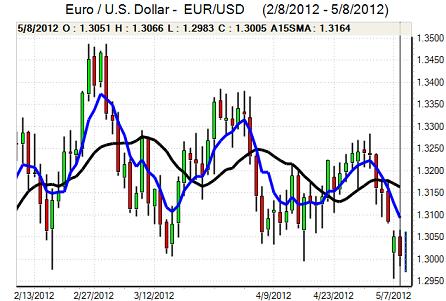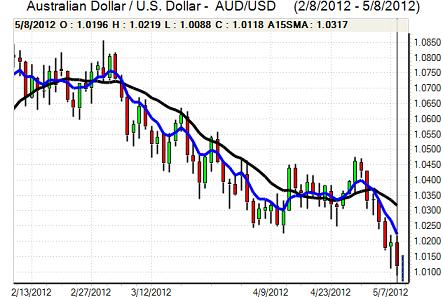EUR/USD
The Euro found some initial support close to 1.30 against the dollar on Tuesday, but rallies faded very quickly and there was a renewed test of support below this level during the US session.
There was further uncertainty surrounding the Greek situation as tortuous political negotiations continued. Following New Democracy’s failure to form a government, the radical left party or SYRIZA has now been given three days to form an administration. Party leader Tsipras stated that the IMF-led programme was null and void following the election given that there was only around 33% support for existing policies.
There will continue to be a high degree of uncertainty over the situation and failure to form a government could trigger fresh elections in June. There was further speculation that Greece would effectively be forced out of the Euro-zone, especially if Greece refused to comply with the troika’s terms.
There was also further uncertainty surrounding French policies while there were acute concerns surrounding the Spanish banking sector with rumours that Bankia was due to be nationalised later this week. There was increased pressure for a fundamental shift in the German policy stance as fear undermined the Euro with a strong German industrial production report reinforcing the regional disparity.
The latest US consumer confidence report registered a slight decline for May, although the impact was limited. Markets were still on edge over the possibility of additional quantitative easing and this kept dollar buying on a relatively tight leash. US Treasury yields also declined to a 3-week low on defensive demand for Treasuries as the S&P index dipped to a two-month low.
There was a sharp drop in oil and gold prices during the US session which undermined commodity currencies and was instrumental in pushing the dollar higher. The Euro weakened to the 1.2970 area in Asia on Wednesday as risk appetite remained weak.

Source: VantagePoint Intermarket Analysis Software
Call now and you will be provided with FREE recent forecasts
that are up to 86% accurate* 800-732-5407
If you would rather have the recent forecasts sent to you, please go here
Yen
The dollar was unable to regain the 80 level against the yen on Tuesday and retreated to lows near 79.70, although ranges were relatively narrow.
The US currency was hampered by a decline in yield support during the day. The yen also gained support on defensive demands as risk aversion generally deteriorated as equity markets remained under substantial selling pressure.
There was nervousness over yen buying, especially given the potential for intervention if the currency strengthened significantly. There was solid yen support on Wednesday as regional equity markets remained weaker with the dollar trapped below 80.
Sterling
Sterling was unable to make any impression on resistance near 1.62 against the dollar in Europe on Tuesday and retreated to lows near 1.6120 as European currencies were subjected to wider selling pressure.
Sterling sentiment was hampered slightly by the weaker than expected housing data reported overnight with fears that a long-term downtrend was resuming. There was also a weaker than expected BRC retail sales report with a 3.3% annual decline for April.
There was further uncertainty surrounding monetary policy with a difference of policy opinion from former Bank of England MPC members with Gieve suggesting that further action could be considered while Sentance stated that policy should be held on hold.
There was further evidence of defensive Sterling demand as UK gilts remained close to record lows and it held above 1.61 against the dollar with the UK currency also pushing towards the 0.80 level against the Euro.
Swiss franc
The dollar pushed to highs near 0.9250 against the franc during Tuesday before edging back to the 0.9220 region later in the US session. The Euro was again trapped very close to the 1.2010 level and indications suggested that the National Bank again was forced to intervene to protect the 1.20 level.
There will be further speculation of defensive inflows into the Swiss currency, especially given a fresh deterioration in Euro-zone sentiment as political stresses intensify. The IMF backed the Euro minimum level as a short-term measure and pressure is liable to build further.

Source: VantagePoint Intermarket Analysis Software
Call now and you will be provided with FREE recent forecasts
that are up to 86% accurate* 800-732-5407
If you would rather have the recent forecasts sent to you, please go here
Australian dollar
The Australian dollar was blocked close to 1.02 against the US currency in early Europe on Tuesday and was subjected to heavy selling pressure with fresh 2012 lows as the currency retreated to lows below 1.01 before a slight recovery.
There was a deterioration in risk appetite as equity markets declined and there was also a sharp decline in commodity prices which undermined confidence in the currency. The 2012/13 budget pledged to push Australia back into budget surplus and the relatively tight spending stance increased speculation over further cut in interest rates. Confidence remained weak on Wednesday and the currency dipped to fresh lows near 1.0050.



